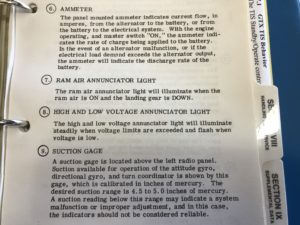Podcast: Play in new window | Download
It’s annual inspection time, and your airplane is going in the shop.
Are you confident? Are you prepared? Will you be involved, and maybe even get your hands dirty?
For an airplane owner, annual inspection time can be frustrating and nerve-wracking, or it can be educational, positive, and hopefully, an efficient experience. A significant part of the outcome depends on you, the airplane owner.
The owner-assisted annual. It’s a concept that’s been around for a long time, and there are strong opinions about it. Some owners love to help and be involved. Others just want to drop the airplane off at the shop and have them call when it’s finished.
But if you’re looking for an opportunity to learn and save some money at the same time, the owner-assisted annual inspection can be a valuable experience.
Jerry is one of those owner-assisted annual types. He’s been helping with his annual inspection on his Mooney M20J for many years. Jerry takes pride in keeping his airplane clean, and in excellent condition. Here are some ways Jerry saves money on his annual inspection.
- Opening and closing inspection covers. This is a task that almost any owner can help with.
- Being willing to do “menial” tasks, like removing old Prop Guard tape from the propeller leading edges. I can certainly do tasks like this, but it’s also a good opportunity for an interested owner to save on labor costs.
- Asking good questions… “What does the POH say about that?”
I noticed there’s a “Ram Air” annunciator light in the instrument panel that illuminates when the control is pulled to the “Open” position. However, when I checked the system in the shop, I noticed the light did not illuminate. I could hear the microswitch clicking as I moved the control, but the light was not working. I was about ready to remove a small cover plate on the instrument panel to take a look at the microswitch and wiring, but Jerry asked me a really good question… “What does the POH say about that?” He pulled the POH out and sure enough, there was a revealing note in there. Here’s the page from the manual: All of a sudden the light came on for me. I realized that when I had checked the Ram Air system, I had the airplane on jacks and the landing gear retracted. In this condition, the light does not illuminate. And as I thought about it more, I realized this makes perfect sense. The light illuminates when the Ram Air door is open and the landing gear is extended, to remind the pilot of the potential of sucking ground-associated dirt and debris into the induction system. In the air while flying, this is not such an issue, and the indicator light is not needed. Once again, I learned some valuable lessons like “Don’t make assumptions,” and “Know the airplane systems,” and “The POH has a ton of good information in it… use it!” Bottom line, I was glad Jerry asked me that good question the other day before I started taking things apart unnecessarily.
All of a sudden the light came on for me. I realized that when I had checked the Ram Air system, I had the airplane on jacks and the landing gear retracted. In this condition, the light does not illuminate. And as I thought about it more, I realized this makes perfect sense. The light illuminates when the Ram Air door is open and the landing gear is extended, to remind the pilot of the potential of sucking ground-associated dirt and debris into the induction system. In the air while flying, this is not such an issue, and the indicator light is not needed. Once again, I learned some valuable lessons like “Don’t make assumptions,” and “Know the airplane systems,” and “The POH has a ton of good information in it… use it!” Bottom line, I was glad Jerry asked me that good question the other day before I started taking things apart unnecessarily.
Here’s another interesting thing that happened during Jerry’s inspection. During the compression test, we found that cylinder #3 was 47/80. This seemed unusually low for a Lycoming engine. After working with it for awhile, we managed to get 59/80, still not very stellar, especially for a Lycoming. There was obviously some leakage past the exhaust valve, and we decided to take a look with the borescope.
Once again, I was reminded of the value of borescoping airplane piston engine cylinders. I was surprised to find the exhaust valve and seat area looked quite good… a different situation than I usually see when borescoping exhaust valves in cylinders with low compressions. So we made the decision to complete the annual, run the engine again, and recheck that cylinder. Amazingly, we got 70 something during the recheck. Another reminder of two things for me: First, ALWAYS borescope the cylinders during annual inspection, both for Continental AND Lycoming engines. And second, never rely on a compression test alone, to determine the health of a cylinder… it’s just not enough information.
So back to Jerry… because he helps with his annual, we are able to charge fewer labor hours. (And at Classic Aviation, LLC, our labor rate is $85 per hour.) Don’t expect to save much the first time you help with your annual inspection, because the time required for training and familiarization will likely cancel out the time saved by you helping. But in future years, it is certainly possible to save on labor hours, especially if you talk about it with your mechanic or shop in advance.
P.S. Listen to the audio for this episode to hear about how Dean was humbled this past week when he flooded an airplane engine, and it just would not start. THIS was a great learning experience!



Recent Comments